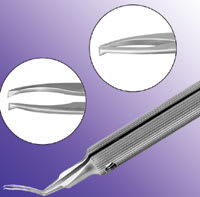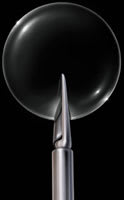instrumentation
What's New in Cataract
Instrumentation?
New
products are finding favor with surgeons.
BY
JERRY HELZNER, SENIOR EDITOR
Although the giant step in cataract surgery took place almost 40 years ago when Charles Kelman, M.D., introduced phacoemulsification, the cataract procedure has continued to evolve and improve with such recent advances as small-incision surgery and bimanual technique.
Just in the past year, a number of companies have launched instruments designed for use in the cataract procedure that are finding favor with surgeons. Following is a sampling of these new instruments:
|
|
|
The DK7788 IOL inserter from AMO. |
Advanced Medical Optics (AMO)
DK7788 Insertion System
AMO (Santa Ana, Calif.) has launched a new syringe-style insertion system, the DK7788. The new inserter, made specifically for AMO by Duckworth and Kent, provides another option for inserting AMO's acrylic IOLs: ReZoom Multifocal, Tecnis (ZA9003) and Sensar with OptiEdge. AMO says the DK7788 inserter automatically rotates the barrel at the appropriate point in the delivery of the lens and provides for truly one-handed lens delivery.
It is a reusable and autoclavable system. Like AMO's current Unfolders, the DK7788 utilizes AMO's current Emerald Advanced Cartridges. Loading the IOL into the Emerald Advanced Cartridge is the same for the DK7788 as for the Emerald Unfolders.
Alcon
OZil Torsional Handpiece
|
|
|
The OZil Torsional Handpiece from Alcon. |
Alcon's (Fort Worth, Texas) lightweight OZil ultrasound handpiece is only available on the Infiniti Vision System. OZil can deliver traditional longitudinal ultrasound, oscillatory torsional ultrasound or a combination of both.
Torsional phaco utilizes ultrasonic oscillations of an angulated tip which virtually eliminates repulsion of nuclear material from the tip. Alcon says the side-to-side movement increases cutting efficiency with an improved thermal safety profile compared to traditional ultrasound.
Mini-flared ABS Tip
Designed to enhance torsional oscillatory performance, the new mini-flared micro bore shaft from Alcon delivers enhanced irrigation and surge suppression vs. standard phaco tips. This tip can be used with the Ultra Micro-Smooth irrigation sleeve to enable torsional microcoaxial lens removal with incisions down to 2.2 mm.
Bausch & Lomb
Stellaris Vision Enhancement System
Not yet available but on the horizon is the Stellaris Vision Enhancement System from Bausch & Lomb (Rochester, N.Y.), which allows cataract surgeons to perform either standard coaxial or sub-2 mm microincision coaxial and bimanual phacoemulsification surgery. The Stellaris system is customizable for either vacuum or flow-based fluidics and ergonomically designed for optimal efficiency and ease of use. The Stellaris system will be rolled out following FDA approval, which is expected in the first quarter of 2007.
|
|
|
The Kavanagh Pre-Chopper from B&L Storz. |
Kavanagh Pre-Chop Instruments
A new series of instruments designed for pre-chopping the lens nucleus is now available from Bausch & Lomb Storz. The Kavanagh Pre-Chopper features a broadened platform tip to effectively insert into the lens nucleus and securely split the lens into the desired segments.
Micro-incision tubular instrument shaft configuration allows insertion through small wounds. The instrument incorporates a round squeeze-action handle which allows for ease of hand placement and rotation of the instrument for passage through the cataract wound. The instrument is available in two sizes; for the 1.5 mm jaw and for the 2.5 mm jaw. The Kavanagh Pre-Chopper may also be used as a nucleus cracker.
Devgan Cataract System
|
|
|
The Devgan Universal Cataract Chopper from B&L Storz. |
The Devgan Universal Cataract Chopper/Multi-Tool from B&L Storz is a universal cataract management tool, allowing multiple functions in one simple and efficient double-ended instrument.
Storz says the Devgan system features a versatile chopping tip that provides excellent control of the nucleus with all chopping techniques: vertical chop, horizontal chop, tilt-chop and others. The chopping tip is gently curved and smooth, designed for protecting the posterior capsule from the phaco probe during nucleus removal. The chopping tip features grooves to engage the optic or haptics for IOL manipulation and for iris push-pull in small pupil cases. The curved tip is also used to lift the corneal incision to ease placement of instruments and stabilize the eye providing countertraction via the paracentesis during IOL implantation, particularly in small incisions. A traditional spatula is provided for intraocular manipulation of iris, lens fragments, or if need be, vitreous.
|
|
|
The Gianetti Capsulorrhexis Forceps from Katena. |
Katena
Giannetti Capsulorrhexis Forceps
One of Katena's (Denville, N.J.) newest instruments for cataract surgery is the Giannetti Capsulorrhexis Forceps. This forceps was designed by Riccardo Giannetti, M.D., of Livorno, Italy, to perform a capsulorrhexis through a 1.5-mm microincision.
Dr. Giannetti saw the advantages of microincision cataract surgery (MICS) but was frustrated with the feel and expense of the instrumentation available. Katena says the ergonomics of his new instrument are consistent with the instrumentation that phaco surgeons have used for the last decade, making the transition to MICS much easier. The Giannetti Forceps features an 8.5 mm diameter round handle with thin, angled shanks that are less than 1 mm wide in the closed position and limited to a maximum spread of 2 mm. The extremely small, delicate tips can be used to make the initial tear as well as to grasp the capsule while performing an anterior or posterior capsulorrhexis.
MicroSurgical
Technology (MST)
Packer/Chang IOL cutter
|
|
|
The Packer/Chang IOL Cutter from MST. |
MST (Redmond, Wash.) says this is the first such instrument that can be introduced through a paracentesis incision. It is an interchangable scissors attachment that fits onto the MST microinstrumentation handle. Using the scissors through the paracentesis allows the surgeon to fixate the optic with a second instrument through the phaco incision to avoid torquing or migration as the optic is cut. MST says the blades are strong enough to cut through a hydrophobic acrylic optic with several bites.
Rhein Medical
Harman Manipulator and Marker
Rhein Medical (Tampa, Fla.) introduces two new instruments developed in coordination with David M. Harman, M.D. The first is the Harman Manipulator. Rhein says this instrument has a mirror-polished distal tip shaped like an olive, designed for sweeping nucleus fragments toward a phaco tip, making clear lensectomies much easier.
The second instrument is the Harman Capsulorrhexis Marker designed to mark a 5-mm circle on the anterior cornea. The marker has a 5-mm inner diameter optical zone for accurate centration of the capsulorrhexis and placement of a multifocal or accommodating IOL. The marker has four elevated radials to assist in centration, two opposing radials with an 11-mm spread for small corneas and two opposing radials with a 12-mm spread for large corneas.
|
|
|
The Harman Capsulorrhexis Marker from Rhein. |
The Sabet Lenticular Safety Net
The Sabet Lenticular Safety Net, developed in coordination with Sina J. Sabet, M.D., is designed to hold and support a dropping lens to safely allow anterior vitrectomy and phacoemulsification to continue. The Sabet Net can support multiple fragments simultaneously.
The Sabet Net provides the length of a cyclodialysis spatula to reach into the vitreous cavity to salvage lens fragments with one instrument.
The 23-g tube fits through a 1 mm paracentesis or pars plana incision, and when opened inside the eye, provides a large surface area for fragment support. Thin and sturdy wires minimize traction in the vitreous while supporting a nucleus. The net is detachable and can be replaced with a new net after use.
Synergetics
Syntrifugal Handle and Capsulorrhexis Forceps
|
|
|
The Syntrifugal Handle from Synergetics can be used with numerous tips. |
The Syntrifugal handle is Synergetics' (St. Charles, Mo.) most advanced handle to date. It is made of titanium and designed for maximum strength and durability.
The innovative rotating shaft allows a surgeon to manipulate the tip into optimum working position and the responsive squeeze actuator reduces fatigue. The Syntrifugal's nose-cone connector and the adaptable set of the handle offers the flexibility of using it with any of Synergetics' Syntrifugal reusable and disposable tips.
|
|
|
The Kelman Forceps can be used with the Syntrifugal handle. |
Synergetics says that one Syntrifugal handle combined with a growing line of Syntrifugal disposable tips offers numerous possibilities in both anterior and posterior procedures.
For example, Synergetics' disposable Kelman Capsulorrhexis Forceps with its curved shaft is one of the many tips available. The curved shaft on this forceps allows easy access to all areas of the anterior chamber.

















